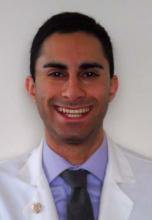ORLANDO – The rates of adjuvant therapy and the use of surgery for resectable stage I and II pancreatic cancer have remained lower than expected, while nonsurgical therapy for the stage II disease has significantly increased, according to an analysis of a national cancer database.
The analysis showed that more patients with stage I and II resectable disease are receiving chemotherapy in addition to surgery, and fewer are undergoing chemoradiation.
But, "despite all the evidence in favor of adjuvant therapy, its use remains unacceptably low," said Siavash Raigani, a second-year medical student at Case Western Reserve University, Cleveland, who presented the abstract at the annual Digestive Disease Week.
Depending on hospital setting and stage, somewhere between one-third and two-thirds of the patients did not receive adjuvant therapy, Mr. Raigani reported.
The analysis also showed that nonsurgical therapy for the disease continues to be used at a high rate, with 43% of stage I and 60% of stage II pancreatic cancer patients undergoing surgery, "which is lower than expected," said Mr. Raigani.
The analysis reflects what previous studies have shown.
In 2007, Dr. Karl Y. Bilimoria and his colleagues analyzed the National Cancer Data Base (NCDB) for the years between 1995 and 2004 and found "the striking underuse of pancreatectomy in the United States. Of early stage pancreatic cancer patients without any identifiable contraindications, 38.2% failed to undergo surgery." (Ann. Surg. 2007;246:173-80).
"What’s more startling is that there has been no improvement in the years since Dr. Bilimoria brought this to our attention several years ago and the authors should be commended for not letting this issue rest," said Dr. John D. Allendorf of Columbia University Medical Center, New York, who called Mr. Raigani’s analysis "impressive."
Mr. Raigani and his colleagues analyzed the NCDB, selecting 47,000 patients diagnosed with stage I and II pancreatic cancer between 2003 and 2010. They analyzed the database on initial treatment – surgery alone, surgery plus chemotherapy, or surgery plus chemoradiation – and collected data on the hospital setting, community hospital or teaching-research hospital.
Results showed that there was no significant change in surgical resection rates for stage I pancreatic cancer during the study period, but there was a significant different between the two hospital settings, with 53% of patients receiving surgery in teaching hospitals, compared with 32% in community hospitals in 2010.
Similarly, the use of surgery for treatment of stage II disease didn’t change significantly over time, but a significant difference remained between teaching hospitals (60%) and community hospitals (52%) in 2010.
One issue in pancreatic cancer keeps coming up over and over again, said Dr. Vic Velanovich, professor of medicine at the University of South Florida, Tampa. "We know who is a resectable candidate based on pathologic criteria, but what we don’t know is should they be getting an operation based on associated comorbidities," he said.
The other issue has to do with where patients are getting these operations done. "The teaching hospitals or high-volume hospitals are all going to have lower mortalities. But the opposite side of that coin is if you’re at a smaller hospital, where your predicted mortality is higher, perhaps by not operating on those patient, you’re actually saving lives, because you’re not subjecting them to postoperative mortality just because of that operation," said Dr. Velanovich, who moderated the abstract session.
Meanwhile, the use of chemotherapy plus surgery for treatment of stage I and II disease increased more than twofold at both types of hospital (P less than .0001). In contrast, use of chemoradiation plus surgery decreased by roughly 30% in both types of hospitals (P less than .05), the authors reported.
The analysis showed that in community hospitals, the rate of chemotherapy for patients with stage I disease receiving surgery increased from 5% to 14%, while the chemoradiation rates decreased from 34% to 19% during the study period. For stage II patients, the rate of chemotherapy increased from 9% to 27%, and chemoradiation rates decreased from 53% to 39% (P less than .0001 for all).
In teaching hospitals, the rate of chemotherapy for stage I patients increased from 6% to 16%, while the chemoradiation rate decreased from 30% to 19% between 2003 and 2010. For stage II patients, the rate of chemotherapy increased from 9% to 32%, while chemoradiation rates decreased from 42% to 30% (P less than .0001 for all).
Mr. Raigani said the increase in the use of chemotherapy concurrent with the decrease in the use of chemoradiation in addition to surgery correlates temporally with the publication of more trials examining chemotherapy only. However, the use of adjuvant chemoradiation was still more common in the United States as of 2010. Among stage I patients, 44% received chemotherapy, compared with 56% receiving chemoradiation. In stage II patients, those rates were 47% and 53%, respectively.

